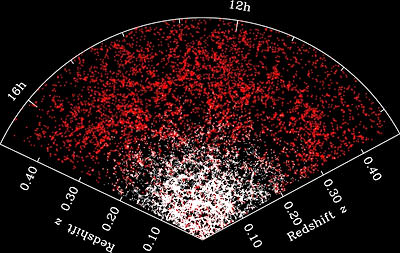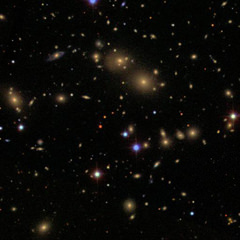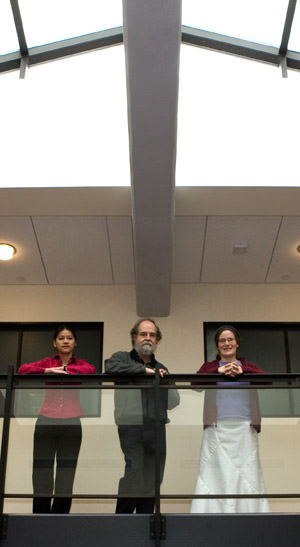[/caption]
Published in 1915, Einstein’s theory of general relativity (GR) passed its first big test just a few years later, when the predicted gravitational deflection of light passing near the Sun was observed during the 1919 solar eclipse.
In 1960, GR passed its first big test in a lab, here on Earth; the Pound-Rebka experiment. And over the nine decades since its publication, GR has passed test after test after test, always with flying colors (check out this review for an excellent summary).
But the tests have always been within the solar system, or otherwise indirect.
Now a team led by Princeton University scientists has tested GR to see if it holds true at cosmic scales. And, after two years of analyzing astronomical data, the scientists have concluded that Einstein’s theory works as well in vast distances as in more local regions of space.

The scientists’ analysis of more than 70,000 galaxies demonstrates that the universe – at least up to a distance of 3.5 billion light years from Earth – plays by the rules set out by Einstein in his famous theory. While GR has been accepted by the scientific community for over nine decades, until now no one had tested the theory so thoroughly and robustly at distances and scales that go way beyond the solar system.
Reinabelle Reyes, a Princeton graduate student in the Department of Astrophysical Sciences, along with co-authors Rachel Mandelbaum, an associate research scholar, and James Gunn, the Eugene Higgins Professor of Astronomy, outlined their assessment in the March 11 edition of Nature.
Other scientists collaborating on the paper include Tobias Baldauf, Lucas Lombriser and Robert Smith of the University of Zurich and Uros Seljak of the University of California-Berkeley.
The results are important, they said, because they shore up current theories explaining the shape and direction of the universe, including ideas about dark energy, and dispel some hints from other recent experiments that general relativity may be wrong.
“All of our ideas in astronomy are based on this really enormous extrapolation, so anything we can do to see whether this is right or not on these scales is just enormously important,” Gunn said. “It adds another brick to the foundation that underlies what we do.”
GR is one, of two, core theories underlying all of contemporary astrophysics and cosmology (the other is the Standard Model of particle physics, a quantum theory); it explains everything from black holes to the Big Bang.
In recent years, several alternatives to general relativity have been proposed. These modified theories of gravity depart from general relativity on large scales to circumvent the need for dark energy, dark matter, or both. But because these theories were designed to match the predictions of general relativity about the expansion history of the universe, a factor that is central to current cosmological work, it has become crucial to know which theory is correct, or at least represents reality as best as can be approximated.
“We knew we needed to look at the large-scale structure of the universe and the growth of smaller structures composing it over time to find out,” Reyes said. The team used data from the Sloan Digital Sky Survey (SDSS), a long-term, multi-institution telescope project mapping the sky to determine the position and brightness of several hundred million galaxies and quasars.
By calculating the clustering of these galaxies, which stretch nearly one-third of the way to the edge of the universe, and analyzing their velocities and distortion from intervening material – due to weak lensing, primarily by dark matter – the researchers have shown that Einstein’s theory explains the nearby universe better than alternative theories of gravity.

The Princeton scientists studied the effects of gravity on the SDSS galaxies and clusters of galaxies over long periods of time. They observed how this fundamental force drives galaxies to clump into larger collections of galaxies and how it shapes the expansion of the universe.
Critically, because relativity calls for the curvature of space to be equal to the curvature of time, the researchers could calculate whether light was influenced in equal amounts by both, as it should be if general relativity holds true.
“This is the first time this test was carried out at all, so it’s a proof of concept,” Mandelbaum said. “There are other astronomical surveys planned for the next few years. Now that we know this test works, we will be able to use it with better data that will be available soon to more tightly constrain the theory of gravity.”
Firming up the predictive powers of GR can help scientists better understand whether current models of the universe make sense, the scientists said.
“Any test we can do in building our confidence in applying these very beautiful theoretical things but which have not been tested on these scales is very important,” Gunn said. “It certainly helps when you are trying to do complicated things to understand fundamentals. And this is a very, very, very fundamental thing.”
“The nice thing about going to the cosmological scale is that we can test any full, alternative theory of gravity, because it should predict the things we observe,” said co-author Uros Seljak, a professor of physics and of astronomy at UC Berkeley and a faculty scientist at Lawrence Berkeley National Laboratory who is currently on leave at the Institute of Theoretical Physics at the University of Zurich. “Those alternative theories that do not require dark matter fail these tests.”
Sources: “Princeton scientists say Einstein’s theory applies beyond the solar system” (Princeton University), “Study validates general relativity on cosmic scale, existence of dark matter” (University of California Berkeley), “Confirmation of general relativity on large scales from weak lensing and galaxy velocities” (Nature, arXiv preprint)


SCIENTISTS CONCLUDE: EINSTEIN WAS REALLY SMART!
Film at eleven. 😉
I got the impression from the press release that the results of this new project only ruled out TeVeS theory: “In particular, the tensor-vector-scalar gravity (TeVeS) theory, which tweaks general relativity to avoid resorting to the existence of dark matter, fails the test.”(From the PR)
Were all other competing theories ruled out here (eg MOND, etc)?
arxiv abstract:
“The measured value excludes a model within the tensor-vector-scalar gravity theory, which modifies both Newtonian and Einstein gravity. However, the relatively large uncertainty still permits models within f(R) theory, which is an extension of general relativity. A fivefold decrease in uncertainty is needed to rule out these models.”
[But look at Fig 2: GR gives the best prediction, no question!]
MOND is already ruled out years ago (can’t predict the Bullet et al clusters), so this work doesn’t need to. But generally a prediction (measurement) can’t be expected to rule out all competitor theories.
TeVeS is MOND, extended to include relativity (well, it’s one such extension; as far as I know, it’s the only such that has not been already ruled out by other considerations).
MOND was never a serious contender as a theory of gravity, because it is inconsistent with relativity (MOND = MOdified Newtonian Dynamics, and Newtonian dynamics have been ruled out for over a century now), and Milgrom (creator of MOND) always expected that an extended version needed to be found (one consistent with the dynamics we know rule the universe).
There are other, alternative, theories of gravity, which can account for the dark energy observations without the need for dark energy (a.k.a. cosmological constant, or quintessence, etc). f(R) is one such, and it is not ruled out by the research presented in the Nature paper.
Jean & Torbjorn,
Thanks for the clarifications and explanations. I also read the entire paper, which I hadn’t had time to consult before posting. Thanks again.
Thank you for a most enlightening article. I don’t know a lot about relativity, and this article has helped me improve that somewhat. And the title is funny!
Interesting —- a large sample space version of the Pound Rebka experiment. This might put the kibosh on MOND and related ideas, but it will not likely silence the EU goofballs who keep posting here.
LC
@ Jon: Thanks, but Jean is the expert here.
It is true that MOND is a set of theories, more so than GR. If you take relativity as opposed to experiment as a prediction (which I agree you should) it was never really a contender – but then it is hard to speak of ruling it out. Seems I wasn’t knowledgeable enough to remove the degeneracy between the initial and the relativity consistent ones. 😮
@ SteveZodiac:
I haven’t really seen a general definition of “reductionism”.
Seems people at times mean that parsimony isn’t guaranteed. Such as in biology, where contingency can make systems take less likely pathways or at least historically seem to after pruning of a set of pathways.
But parsimony is a relative measure for when theories makes the same predictions, never a guarantee. So there isn’t really a reductionism in such a sense.
Other times it seems that people refer to using such methods as parsimony or minimal theories (most predictions for least theory) avariciously.
Here it depends. In biology for example there is a complaint that selection is often taken as a null hypothesis (not in the probabilistic sense but as the reference). But it can be merely a science program to test that prediction first, moreover shored up by that near neutral traits can drop out of fixation or even disappear easier than selected ones.
Finally, it seems that some people dismiss the existence of effective and/or emergent theories. That is plain unsubstantiated by observation.
So FWIW it seems to me science is reductionist however you cut it, and moreover is observed to work well doing so. The minute problem of people avariciously going for reductionism even when it is the wrong choice resolves itself by the competition on “the market of ideas”.
DM is reductionist to the extreme. Lambda-CDM uses what, 5 free parameters IIRC, to predict all of cosmology. Without DM you need one theory for each cluster such as the Bullet, or so I understand of theoretical astrophysicist Ethan Siegel of “Starts with a bang”:
That is reductionism. One theory (and only 5 free parameters) predicts everything. (Well, in a manner of speaking. ;-))
I don’t have a PhD in Astrophysics (yet) but I am a reductionist, mainly because past discoveries have always come up with a simple, elegant answer e.g. Kepler’s oval orbits versus Ptolomy’s epicycles, so like a lot of folk I am deeply suspicious of answers that add things in to solve an anomaly. I remain a DM skeptic and I think Einstein would as well.
“Any fool can make things bigger, more complex, and more violent. It takes a touch of genius — and a lot of courage — to move in the opposite direction.” A.E.
@LBC Einstein was an EU goofball.
Excellent article Jean, and well explained for us neophytes (and EU goofballs)
Torbjorn Larsson OM said;
“@ SteveZodiac:
I haven’t really seen a general definition of “reductionism”.”
Eh? We are taking about science here?
Surely the argument here is around reductionism v. holism.
The most successful scientist is able to interchange between the two philosophies. (Suggest you read the ol’ Douglas Hofstadter, which discusses thinking and creativity.)
Sorry Torbjorn. What has parsimony got to do with it?
MOND and its tensor-vector relative are really phenomenological tools. They should be seen as something similar to form factors or partons in quantum mechanics and field theory. In the absence of explicit knowledge of the source of a field you construct deformations of the field to reflect some observations and measurements. These are not fundamental theories, though some have touted MOND as such. MOND work is not useless by any means, for it does provide a bench on which metal is bent to find how observations fit physical theory.
The classical theory of gravity which clearly governs the large scale universe is general relativity. Of course tests still need to be performed, in particular the detection of gravity waves. So GR is not taken as a matter of faith, but it is pretty clearly the structure of spacetime and gravity.
Oh, and yeah — Einstein was not an EU theory guy. If he were alive to today to see how it is being upheld by people, who often have little physics education, as some alternative to gravitation he would likely remark on how puerile and childish this all is.
LC
Prime,
I’ve deleted the link in your comment; promotion of personal theories is not acceptable here (please read the Comment policy).
I should add that promotion of the “Electric Universe” cult is also not acceptable (your link contains direct promotion of that cult).
If you are interested in finding out more, or in having your personal theory discussed, I recommend the BAUT Forum, which is part-owned by Fraser Cain.
Finally, calling peer-reviewed science “propaganda” is most certainly not being nice; please do not use such language again.
More Gravity only, Einstein, Princeton establishment, propaganda.
Prime